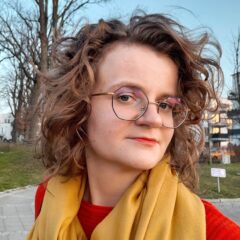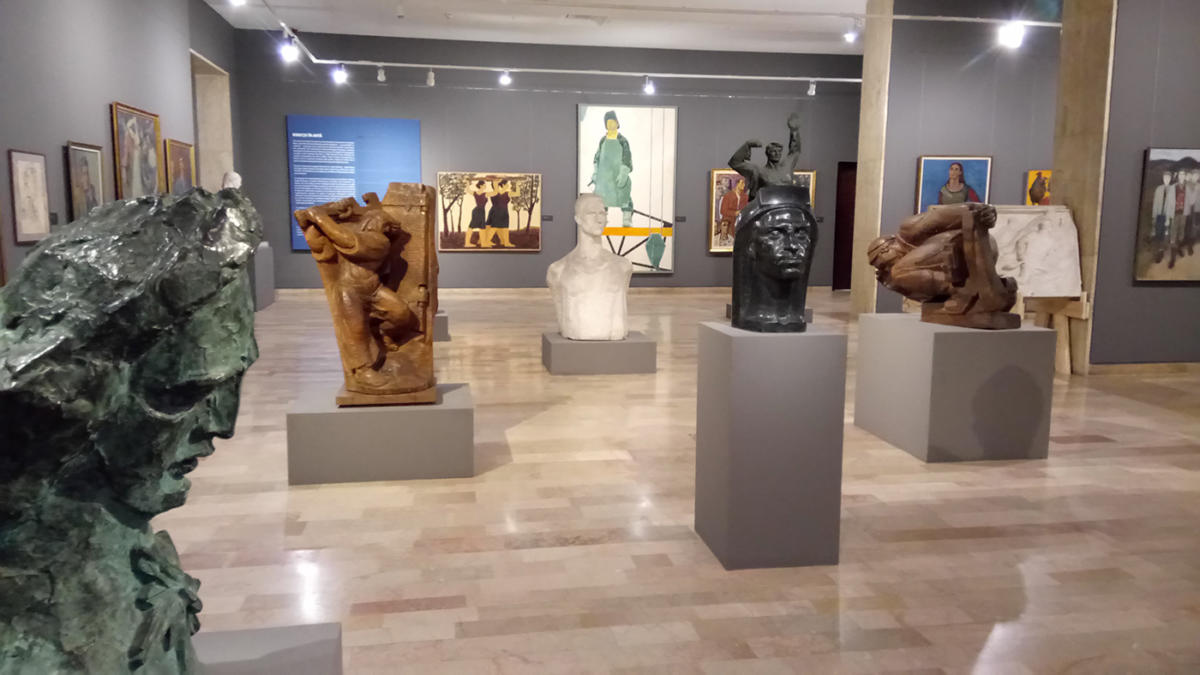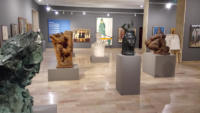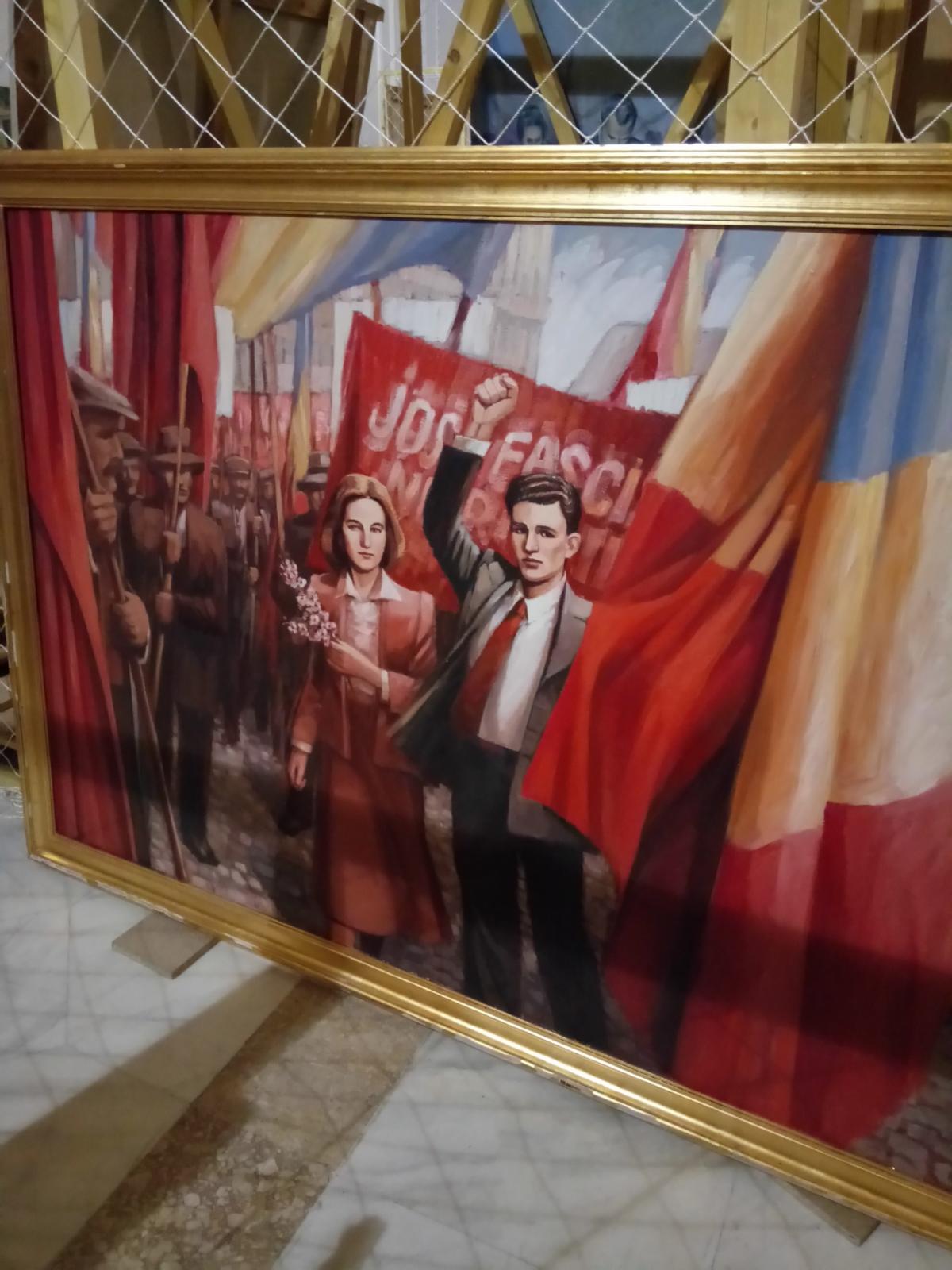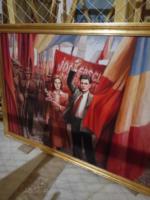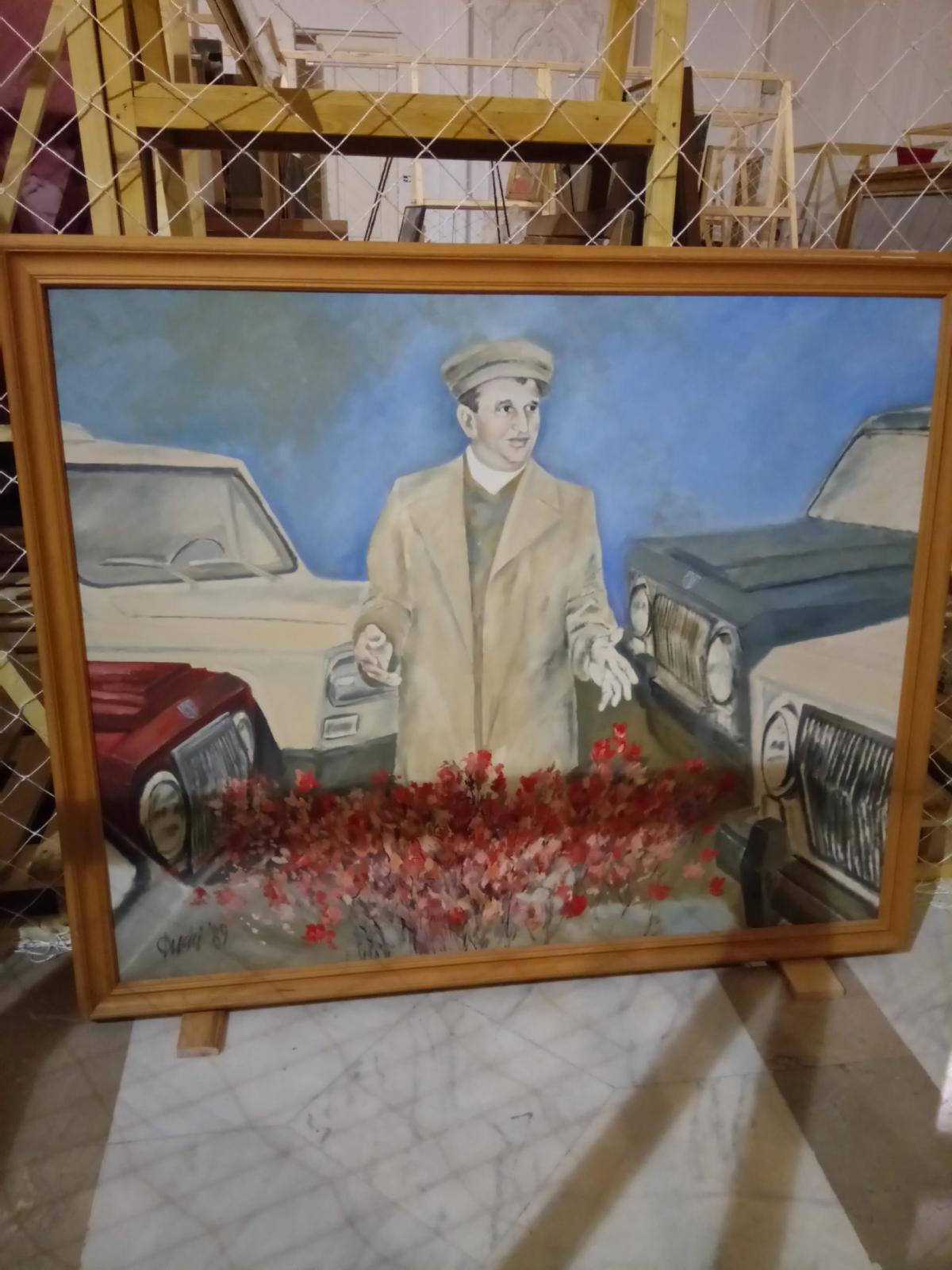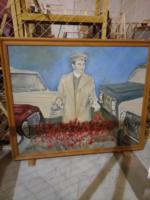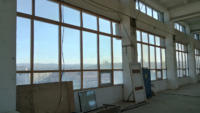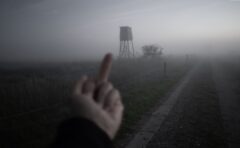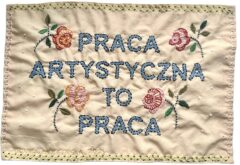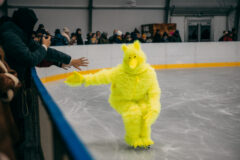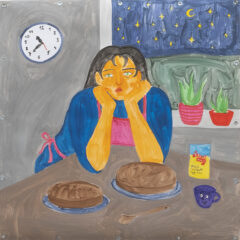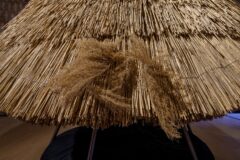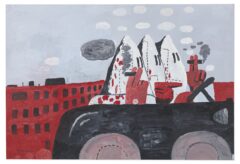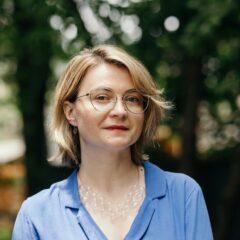Munți de căcat. Opowieści z gorszej części Europy [PL/EN]
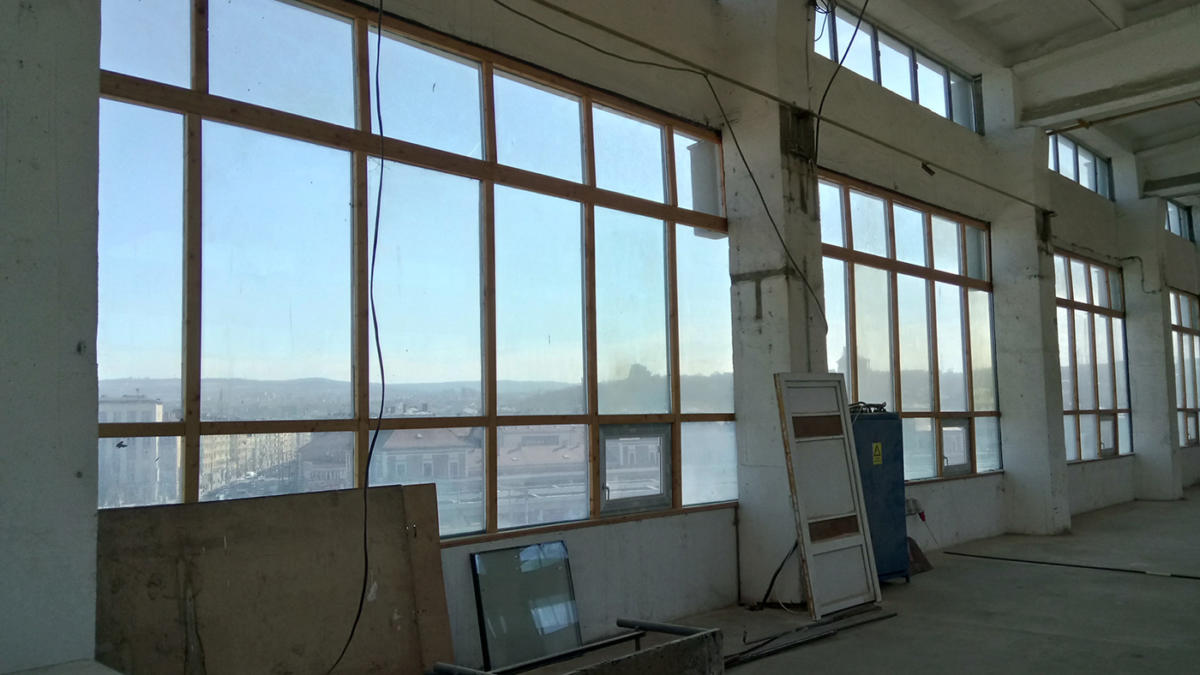
Idea integracji środkowo-europejskiej zaprawdę piękną jest i warto ją pielęgnować, także w sztuce. Jeszcze nie tak dawno temu zazdrościłam Ziemowitowi Szczerkowi podróży na Ukrainę, mocno zakrapianych słynnym balsamem Vigor, a teraz sama zaczynam wchodzić w jego buty, ochoczo nawiązuję przyjaźnie z sąsiadami i poznaję zdawałoby się, że egzotyczne krainy. Na przykład taka Rumunia. Gdybyście jakiś czas temu temu zadali mi pytanie o tamtejszą sztukę, ciąg myślowy byłby raczej krótki: Kluż, Fabryka Pędzli, galeria Plan B, malarstwo Serbana Savu. Przecież w końcu nawet w warszawskiej Zachęcie mogliśmy oglądać wystawę obrazów Victora Mana w 2014 roku i dzięki temu wiemy, że tak zwana „szkoła z Klużu” to zjawisko ciężkie, gustujące w błotnych kolorach i epatujące melancholijną aurą, co przyczyniło się zresztą do znaczącego sukcesu malarzy z tego nurtu.
Proweniencja tej specyficznej estetyki staje się mniej więcej jasna już przy samym wjeździe do Bukaresztu, który w zasadzie można porównać do wjazdu do Warszawy, tylko że jest gorzej. Przy drodze ciągną się więc liany kabli na lichych, drewnianych słupach – zjawisko przybliżone już polskiemu czytelnikowi przez reportażystkę Małgorzatę Rejmer – którym towarzyszą rozbebeszone i niechciane billboardy oraz wielkie hale Ikei, Leroy Merlin i tym podobnych sieciówek. Całość podświetlona swojskimi, pomarańczowymi lampami daje futurystyczno-postkatastroficzny efekt, który można podziwiać także w centrum. A tam dodatkowo, oprócz elektrycznych gniazd ulice zdobią liczne stada samochodów, anektujące każdą wolną przestrzeń chodnika, tak więc potencjalnym przechodniom nie pozostaje właściwie nic innego, jak iść drogą. Zagęszczenie aut i dzika mikroarchitektura drogowa są tak osobliwe dla tego miasta, że stały się nawet inspiracją dla Vlada Nancy, jednego z artystów, którego miałam przyjemność poznać w Rumunii.
Tak samo jak ściśnięte bukareszteńskie niebo i ziemia jest i środowisko artystyczne, małe i ponoć zakiszone w sobie. „Bukareszt to nie Warszawa” – słyszałam nieraz od napotkanych po drodze tubylców, a wszelkie wysiłki wytłumaczenia kryzysowej sytuacji w Polsce i naszych desperackich prób powstawania z kolan spotkały się z niezrozumieniem. Z dużym zdziwieniem musiałam więc przyjąć rolę przybysza z kraju sukcesu i przyglądać się rumuńskiej porażce, która jest mi – bądź co bądź mieszkance tej gorszej części Europy – nie taka znowu obca.
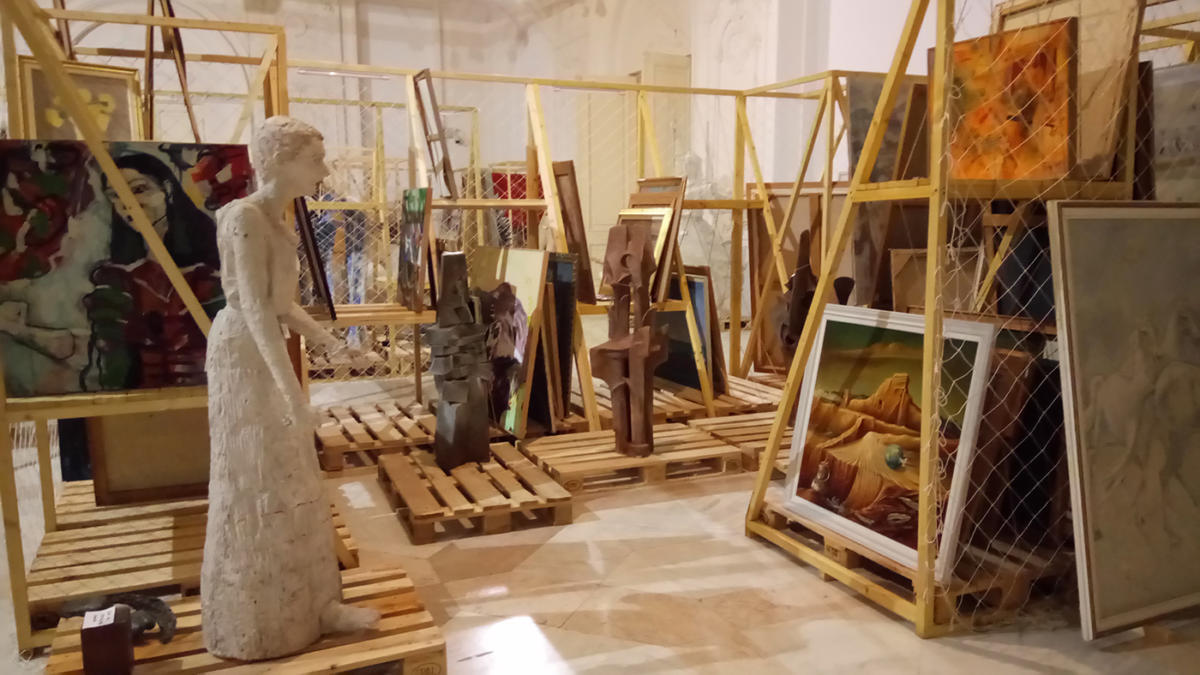
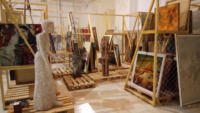
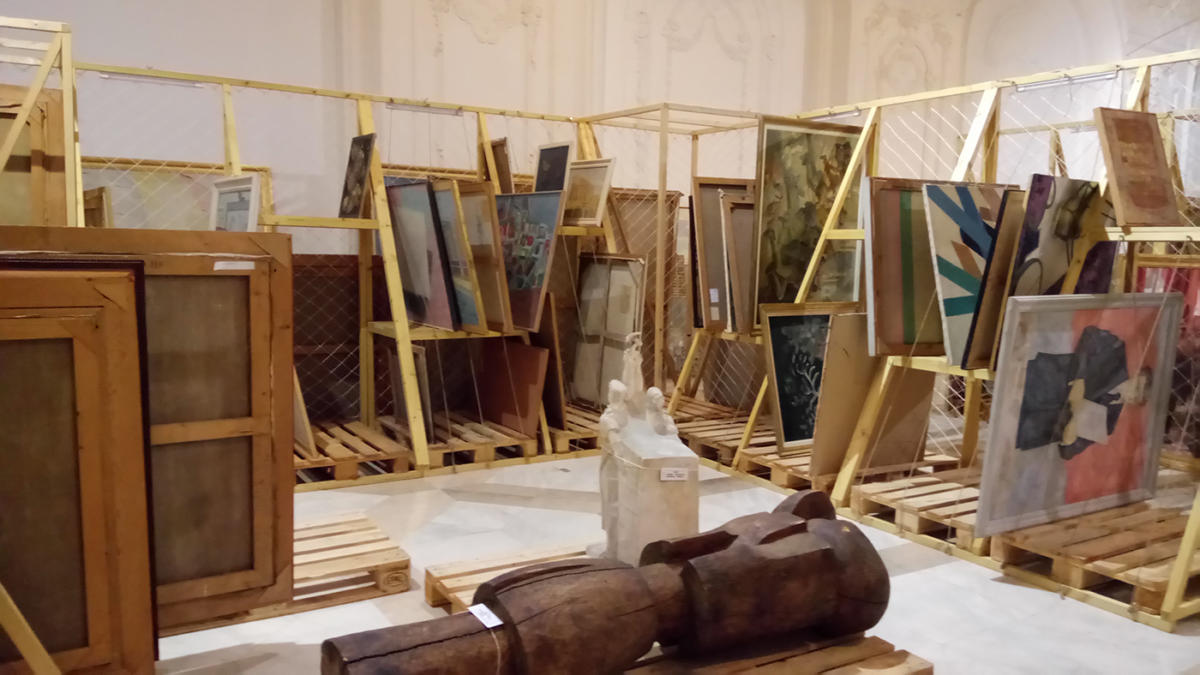
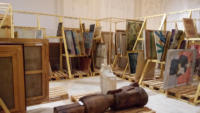
Wietrzenie komunizmu
Trzeba przyznać, że w porównaniu do dość jednak rozbudowanej sceny w Polsce rumuńska wypada skromnie, bo składają się na nią raptem trzy miasta – Bukareszt, Kluż-Napoka i Timișoara. Niektórzy twierdzą, że jacyś artyści żyją jeszcze w Iași, mieście zlokalizowanym niedaleko granicy z Mołdawią, ale lata swojej artystycznej świetności przeżyło ono w latach 90. i dzisiaj raczej nie ma po co tam jechać. Jeśli zaś chodzi o instytucje prezentujące sztukę, to w samym Bukareszcie są raptem dwie – Muzeum Narodowe, którego kolekcja kończy się na sztuce wczesnego modernizmu oraz Narodowe Muzeum Sztuki Współczesnej MNAC. Jak przystało na instytucję narodową, ma ono również kolekcję narodowych dóbr artystycznych, porównywalną choćby ze zbiorami Narodowej Galerii Sztuki Zachęta – a więc jest to typowe, postkomunistyczne mydło i powidło, w którym prace dobre są zdominowane przez mierne. Obecnie zbiory te można podziwiać na ekspozycji Marshalling Yard, odświeżanej raz na pół roku i prezentowanej na parterze muzeum. Na pierwszy rzut oka przestawia się ona interesująco – ciekawie jest w końcu przyjrzeć się takiej kolekcji, będącej świadectwem komunistycznego systemu artystycznego, a polskiemu odbiorcy może ona przypominać świetną wystawę Skontrum zorganizowaną w Królikarni, w ramach której rzeźby ze zbiorów Muzeum Narodowego w Warszawie zostały przekształcone w jedną, ekspresyjną instalację i uzupełnione pracami młodszych twórców (Nicolasa Grospierre’a, Agnieszki Polskiej i Jana Szewczyka). Jednak w przeciwieństwie do warszawskiego pokazu, ten w MNAC ma czysto praktyczne uzasadnienie – muzeum remontuje swoje magazyny i część kolekcji po prostu składuje w salach wystawienniczych. Nie ma więc co szukać głębszego sensu w tej ekspozycji, która w zasadzie jest też antyekspozycją (część prac jest zamknięta w pudłach lub ustawiona tak, że nie da się ich oglądać) i jako taka może być rozumiana jako performans muzealniczej nieświadomości.
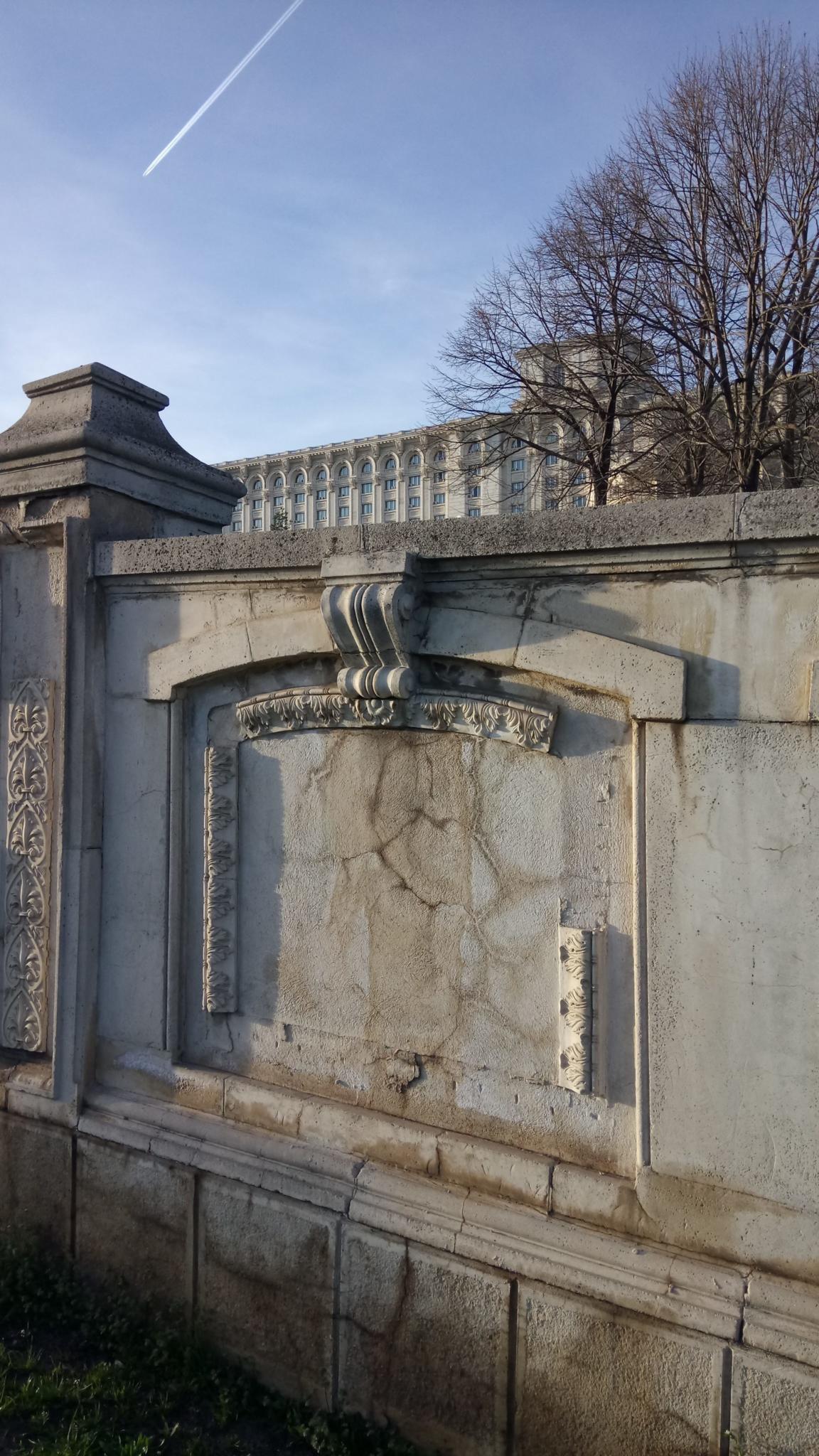
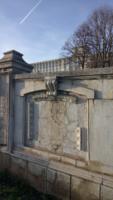

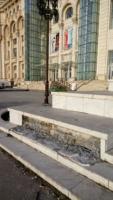
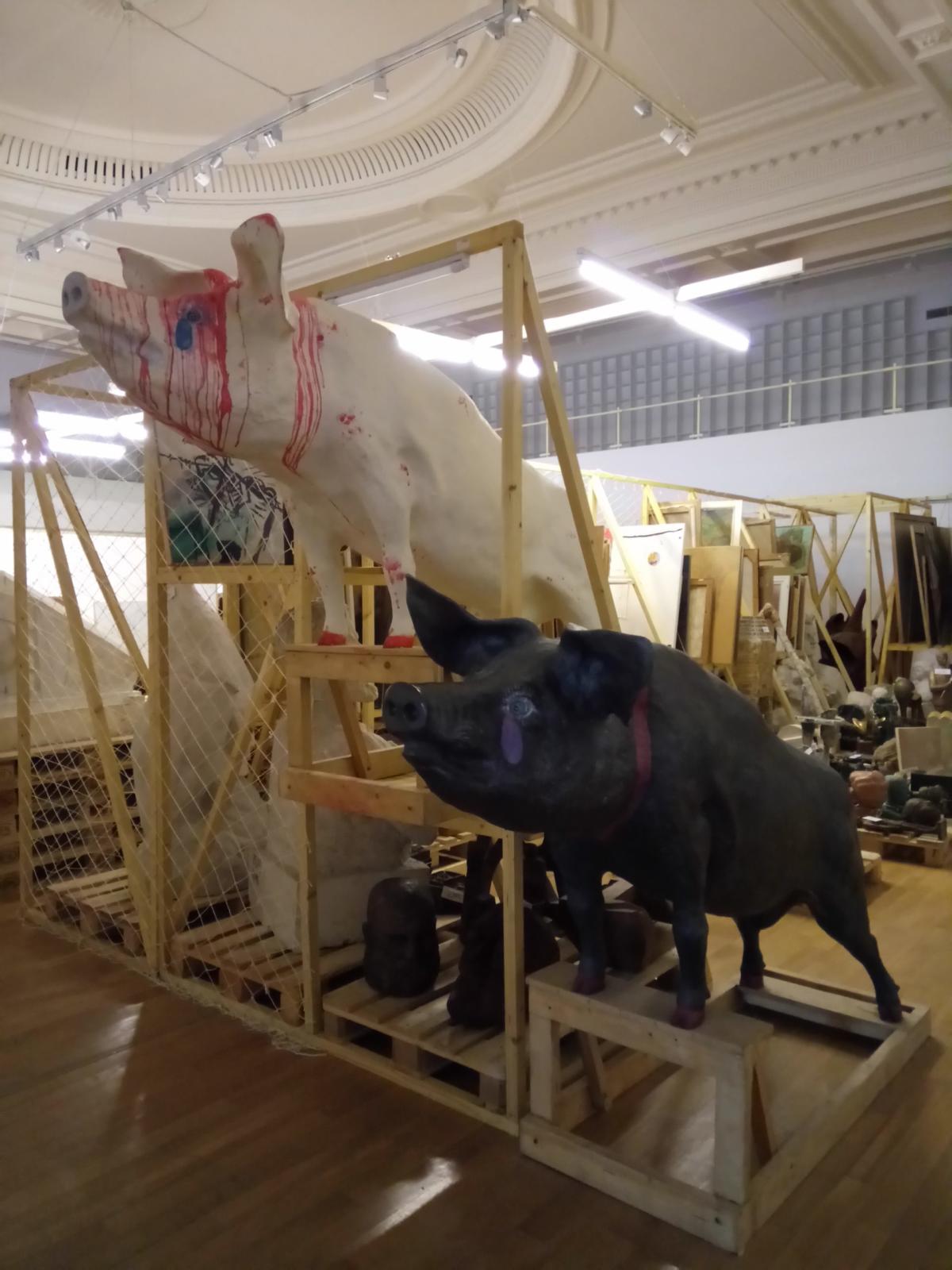
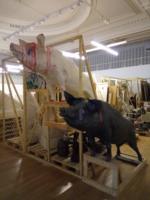
MNAC-owi udaje się być instytucją doskonale nijaką. Pisał już o tym Piotr Piotrowski, który strategię muzeum określił jako „traumafobiczną” – uciekającą od traumatycznej przeszłości i koncentrującej się na prezentacji sztuki globalnej.
Na tym jednak polega urok MNAC-u – instytucji właściwie przygniecionej komunistycznym dziedzictwem, którą jednak postanowiło zdecydowanie ignorować. Muzeum mieści się w słynnym Pałacu Parlamentu, jednym z największych budynków na świecie i architektonicznym dziecku Nicolae Ceaușescu – budowli zadziwiającej i wrogiej dla człowieka, dzięki której 7 kilometrów centrum Bukaresztu zmieniło się w pustynię. Idzie się do tego MNAC-u strasznie długo, bo choć bram do Parlamentu jest kilka, to miłośnik sztuki może użyć tylko jednej. Oczom tych, którym uda się wykonać długą wycieczkę wzdłuż rozlatującego się, betonowego płotu, oddzielającego teren parlamentu od miasta, ukaże się zdziczały „ogród” na tyłach pałacu i kolejna budowla w procesie – gigantyczny monastyr, rumuński odpowiednik polskiej Świątyni Opatrzności Bożej. „W Rumunii kościół był zawsze blisko władzy” – zostaję poinformowana przez znajomych i trudno tej bliskości zaprzeczyć, a właściwie sąsiedztwu drzwi w drzwi. Na tym radioaktywnym tle MNAC-owi udaje się być instytucją doskonale nijaką. Pisał już o tym Piotr Piotrowski, który strategię muzeum określił jako „traumafobiczną” – uciekającą od traumatycznej przeszłości i koncentrującej się na prezentacji sztuki globalnej. Co prawda nowy dyrektor placówki, Călin Dan, artysta i niegdysiejszy członek grupy subREAL stawia sobie za cel prezentację niedocenionych klasyków sztuki rumuńskiej XX wieku (takich jak Mihai Olos, który zasłużył sobie w tej instytucji na aż dwie wystawy pod rząd), to jednak pod wieloma względami kontynuuje traumafobiczną politykę swojego poprzednika, Mihaiła Oroveanu.
W trakcie mojej wizyty w muzeum, oprócz zadziwiającego „pokazu” kolekcji mogłam więc obejrzeć wystawę Olivera Resslera, a także performans Ciana McConna i Vivienne Griffin, który był projektem organizowanym z kuratorskiego open calla. Wydarzenie to wydaje się idealnie wpisywać w zakreślone przez Piotrowskiego ramy traumafobii. Performans McConna i Griffin był w zasadzie bardzo interesujący – poświęcony życiu „po internecie”, rozpływający się pomiędzy wystawą, koncertem i pokazem choreograficznym, dawał miłe poczucie otarcia się o profesjonalną, zachodnią sztukę – ale miał się właściwie nijak do lokalnego kontekstu. O dopasowaniu tego wydarzenia do programu instytucji z kolei nawet trudno mówić, skoro jego 40% to właśnie projekty wyłonione z konkursu. Tę dziwną sytuację tylko trochę polepszała zamykana właśnie wystawa Botei Bucan, która w swoich pracach skupia się na różnych politykach pamięci i temat Pałacu Parlamentu był jedną z poruszanych przez nią kwestii. Pytanie tylko jak ma się ten pojedynczy gest artystki w porównaniu do pielęgnowanej przez muzeum strategii uciekania od trudnych tematów?
Operacja na otwartych ranach
MNAC, pozostający pod rządami artysty-dyrektora ze pokolenia naznaczonego post-komunistyczną traumą, raczej nie będzie w najbliższym czasie instytucją, która zechce wziąć na swoje barki społeczną dyskusję o przeszłości kraju. Co jednak ciekawe, taki wysiłek podjęło bukareszteńskie Muzeum Narodowe, gdzie pod koniec 2016 roku otwarto wystawę Art for the people?, będącą pierwszym pokazem sztuki komunistycznej z Rumunii – już nie takim, którego celem jest przewietrzenie magazynów, ale starającym się pioniersko naświetlić wypchnięty ze zbiorowej pamięci okres w sztuce. Jej kuratorka, Monica Enache, która jest badaczką pracującą w departamencie sztuki modernistycznej muzeum, należy już do tej generacji, która komunizm wygrzebuje z mglistych dziecinnych wspomnień, może więc spojrzeć na ten czas z dystansu, przy założeniu, że jego krytyczna analiza jest konieczna dla zrozumienia własnej historii i kultury. Skalę jego zapomnienia z kolei uzmysławiają deklaracje kuratorki, która w wywiadzie dla magazynu ARTA przyznała, że pracowała na materiałach nietkniętych do lat i opracowywała je jako pierwsza, więc faktycznie przypadła jej rola kreatorki dyskursu. Z polskiej perspektywy jest to wyznanie zaskakujące, pamiętając, że badania nad sztuką socrealistyczną są tutaj prowadzone od lat 80., pierwsza wystawa sztuki socrealistycznej miała miejsce w 1987 roku (Oblicza socrealizmu, Muzeum Narodowe w Warszawie), a w 1994 roku w Pałacu w Kozłówce otwarto Galerię Socrealizmu. Sztuka socrealistyczna jest w Polsce także ciągle analizowana, w nawiązaniu choćby do postaci Andrzeja Wróblewskiego i jego mezaliansu z tym nurtem, czy poprzez związki z komunizmem zachodnim, jak to miało miejsce w przypadku wystawy Daleko od Moskwy. Gérard Singer i sztuka zaangażowana w Muzeum Narodowym w Szczecinie (2016, kurator: Szymon Piotr Kubiak).
W MNAC zobaczymy powstające w latach 80. liczne portrety Ceaușescu z żoną i inne dzieła propagandowe, uświadamiające widzowi, że sztuka tego rodzaju była uprawiana w Rumunii w zasadzie aż do 1989 roku.
Przyczyn tak późnego podjęcia tematu socrealizmu trzeba chyba szukać w sytuacji politycznej w Rumunii, gdzie reżim był po prostu silniejszy niż w Polsce, tak więc problem prorządowej produkcji artystycznej jest tam faktycznie ciągle „otwartą raną” – jak to ujmuje sama Enache. W tym sensie trzeba pogratulować jej determinacji i odwagi w odgrzebywaniu zapomnianych dzieł. Szkoda tylko, że temat nie został ujęty ciekawiej czy bardziej prowokująco – Art for the people? to wystawa stosunkowo prosta, klasycznie bazująca na chronologicznym uporządkowaniu prac i dzieląca zebrane dzieła sztuki na zasadniczo dwa okresy: czasy rządów Gheorghe Gheorghiu-Deja (1948-1965) oraz Nicolae Ceaușescu (1965-1989). Kuratorka wystawy stara się także rozprawić na niej z popularnym przeświadczeniem, że po 1956 roku artystom udało się do pewnego stopnia odzyskać wolność artystyczną i pokazuje, że nawet jeśli w latach 60. poluzowały się formuły stylistyczne socrealizmu, to obowiązywał on ciągle w wymowie dzieł. Rezultatem takiej liberalizacji doktryny były takie prace jak choćby obraz Zbiór owoców Iona Alina Gheorghiu z 1962 roku czy Traktorzysta Evy Cerbu Siegler (obie prace z 1962 roku), które powstały pod wyraźnym wpływem awangardy francuskiej połowy XX wieku. Biorąc pod uwagę przełomowość tej wystawy, aż szkoda, że w zasadzie na tym odkryciu śledztwo kuratorki się kończy i swoich rozważań nie ciągnie dalej, choćby analizując relacje ówczesnej rumuńskiej sceny z Zachodem (skoro wpływy były tak silne). Wystawa mogłaby też objąć przynajmniej część prac pokazywanych równolegle w MNAC, gdzie zobaczymy powstające już w latach 80. liczne portrety Ceaușescu z żoną i inne dzieła propagandowe, uświadamiające widzowi, że sztuka tego rodzaju była uprawiana w Rumunii w zasadzie aż do 1989 roku. Największe dzieło wizjonera Ceaușescu, jego pałac, nie został przecież ukończony i obecnie funkcjonuje jako podupadający relikt-w-procesie; konfrontacja z tym kompleksem i okalającą go miejską pustynią może być faktycznie traumatycznym doświadczeniem. Wydaje mi się więc, że wystawa Moniki Enache jest o tyle znacząca, że otwiera dość istotną dla sztuki rumuńskiej dyskusję, ale jest to zdecydowanie dopiero jej początek.
Ciekawe w tym kontekście jest pytanie, kto taką debatę mógłby kontynuować w Rumunii. Pozostałe działające w Bukareszcie galerie lub pomniejsze „inicjatywy” zdają się być raczej skupione na współczesności lub dowartościowywaniu historycznych zjawisk sytuujących się poza politycznym mainstreamem. Podczas mojej wizyty w Rumunii udało mi się więc zobaczyć niewielką wystawę Situations and concepts w Salonul de proiecte (galerii nota bene działającej przez pierwsze lata jako część MNAC-u, a obecnie niezależnie), która była w pokazem archiwów wystawy sztuki konceptualnej o tym samym tytule, zorganizowanej przez Decebala Scribę w Bukareszcie w 1974 roku. Dla osoby spoza rumuńskiego środowiska może być to wystawa nieco hermetyczna i nieszczególnie wciągająca, ale wydaje mi się, że jest to generalny problem z pokazywaniem sztuki konceptualnej XX wieku, po której zostają jedynie zdjęcia, zapiski i efemeryczne dokumenty, zwyczajowo zamykane w szklanych gablotach, więc trudno czerpać z oglądania takich pokazów jakąś szczególną przyjemność. Co jest jednak może istotniejsze, to fakt, że Situations and concepts jest właściwie częścią większego procesu odkurzania rumuńskiej neoawangardy, a kolejnym wydarzeniem z tej serii jest otwarcie wspomnianej już, kolejnej wystawy Mihaia Olosa w MNAC.
Nowy Berlin jest fajny, ale stary – lepszy
Ponieważ w Bukareszcie miałam raczej szczęście do wystaw odkopujących mniej lub bardziej zapomniane historie z kulturowej przeszłości (na przykład wystawa gejowskich magazynów i homo-archiwum Adriana Newella Păuna w niekomercyjnej galerii ODD, działającej na bukareszteńskiej starówce), albo natrafiałam na pokazy artystów posiadających już ustaloną „renomę” w świecie sztuki (jak Pavel Brăila, którego wystawa w Eastward Prospectus poprzedzała występ artysty na Documenta 14) w poszukiwaniu świeższych zjawisk postanowiłam wybrać się do Klużu-Napoki, północnego ośrodka galeryjnego. Ten na swój sposób heroiczny wyjazd (po 8 godzinach w rumuńskim pociągu zatęskniłam gorąco za polskimi Intercity i Pendolino) opłacił mi się o tyle, że była to okazja do dokładnego zapoznania się z kulisami lokalnego środowiskowego konfliktu, dzięki któremu w ostatnich miesiącach nastąpił spektakularny „rozwód” tamtejszych galerii, do tej pory działających wspólnie w Fabryce Pędzli. Mówiąc szczerze, zrobienie dokładnej sondy na temat tego, kto kogo oszukał, wykorzystał i kto zagrabił wspólne fundusze było dużo ciekawsze od wystaw, które trwały wtedy w Fabryce Pędzli, dość zresztą opustoszałej, bo część galerii przenosi się właśnie do nowego budynku tuż przy dworcu kolejowym. Udało mi się więc zobaczyć tam doskonale nudny pokaz abstrakcyjnego post-malarstwa dwóch berlińskich artystów, Philippa Rößle i Linusa Rauch, a także „wystawę” bardzo młodej artystki Larissy Danilov pochodzącej z Iaşi, która na jednej z półek na książki w kawiarni urządziła mini pokaz slajdów, eksplorujący temat brzydkich swetrów. Trudno powiedzieć, żeby był to temat przejmujący na wskroś. Odwiedziłam też galerię Superliquidato, która była akurat w trakcie przygotowań do otwarcia wystawy Bianki Trifan, niepokojąco kojarzącej mi się z twórczością Iwony Demko. Być może więc wyjechałabym z miasta zupełnie załamana, gdybym nie natrafiła na jednowieczorną wystawę w studenckiej galerii Pages per minute. Jej działanie oparte jest na prostym i fajnym pomyśle urządzania wystaw prac wydrukowanych na ksero, łatwych do powielenia i rozdawania. Wernisaże odbywają się zawsze w innym miejscu, a jedynym elementem stałym w galerii jest neon z jej nazwą, oraz, jak podejrzewam, tłum dwudziestolatków szczelnie zapełniający wybraną „miejscówkę”. Prace pokazywane na wystawie prezentowały bardzo różny poziom, ale dzięki swojej energiczności i bezpretensjonalności wydarzenie to było dla mnie namiastką bujnego, galeryjnego życia w Klużu, które ponoć się tu toczy.
Wyprowadzka Planu B z Rumunii jest ciekawym sygnałem co do specyfiki tej sceny, która najwyraźniej – jeśli chodzi o rynkową widzialność – nie jest wystarczająca.
Kluż-Napoka jest określany przez tubylców jako „nowy Berlin” i bez wątpienia jest to miasto konkurujące z Bukaresztem, nawet pomimo braku jakiejkolwiek sensownej instytucji artystycznej (lokalne muzeum sztuki to skostniała placówka która jeszcze nie wygrzebała się z komunistycznych standardów). Trochę gorzej wypada na tle wspomnianej stolicy Niemiec, z którą jednoznacznie przegrywa, o czym świadczy wyprowadzka najważniejszej rumuńskiej galerii komercyjnej – Planu B – właśnie do Berlina. Teoretycznie w Klużu-Napoce nadal działa rumuński oddział galerii, ale bardziej w teorii niż w praktyce, co wydaje mi się sprytnym wybiegiem ze strony właścicieli, którzy z jednej strony chcą działać w realnym centrum artystycznym, ale starają się utrzymać pozory swojej unikalności. Wyprowadzka Planu B z Rumunii jest też ciekawym sygnałem co do specyfiki tej sceny, która najwyraźniej – jeśli chodzi o rynkową widzialność – nie jest wystarczająca. W Polsce oczywiście też nie ma wielkiego rynku, ale co ciekawe, nikt tutaj nie decyduje się na wyprowadzkę lub otwieranie filii w zachodnich centrach artystycznych. Najważniejsza z nich, Fundacja Galerii Foksal, zainwestowała wręcz ostatnimi czasy w spektakularny betonowy budynek, a jego ciężkość, mogąca przywodzić na myśl renesansowe, forteczne palazzo (do pełni szczęścia galerii brakuje już tylko fosy wypełnionej rekinami i piraniami gustującymi w lokalnych neofaszystach) wymownie świadczy o gotowości Fundacji do pozostania na swoim miejscu. To oczywiście jednak nie znaczy, że polscy galerzyści zainteresowani są tylko działalnością na własnym poletku – swoich artystów promują poprzez kooperację z zagranicznymi instytucjami artystycznymi i obecnością na międzynarodowych targach.
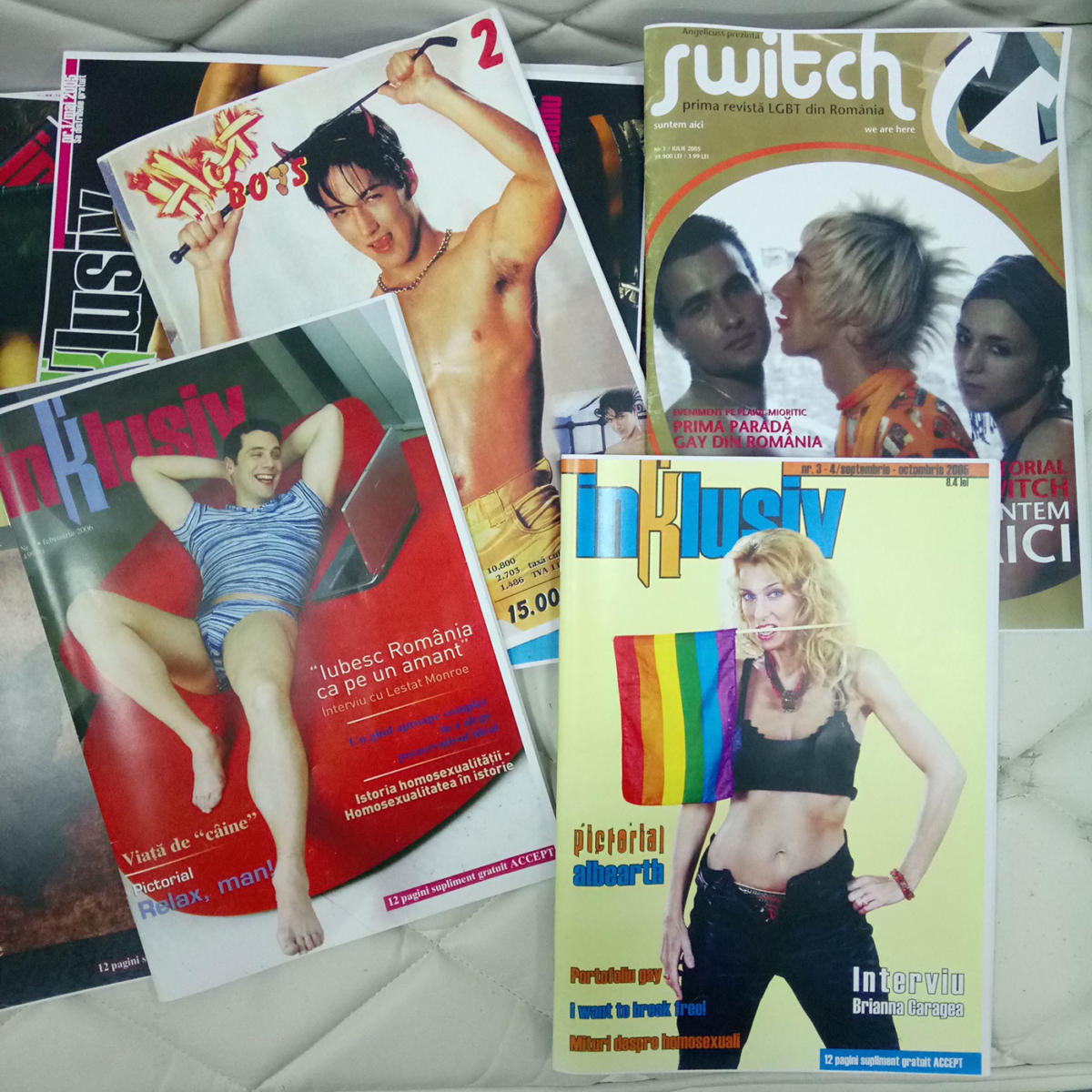
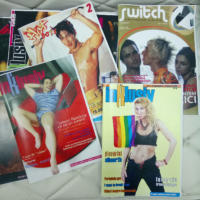
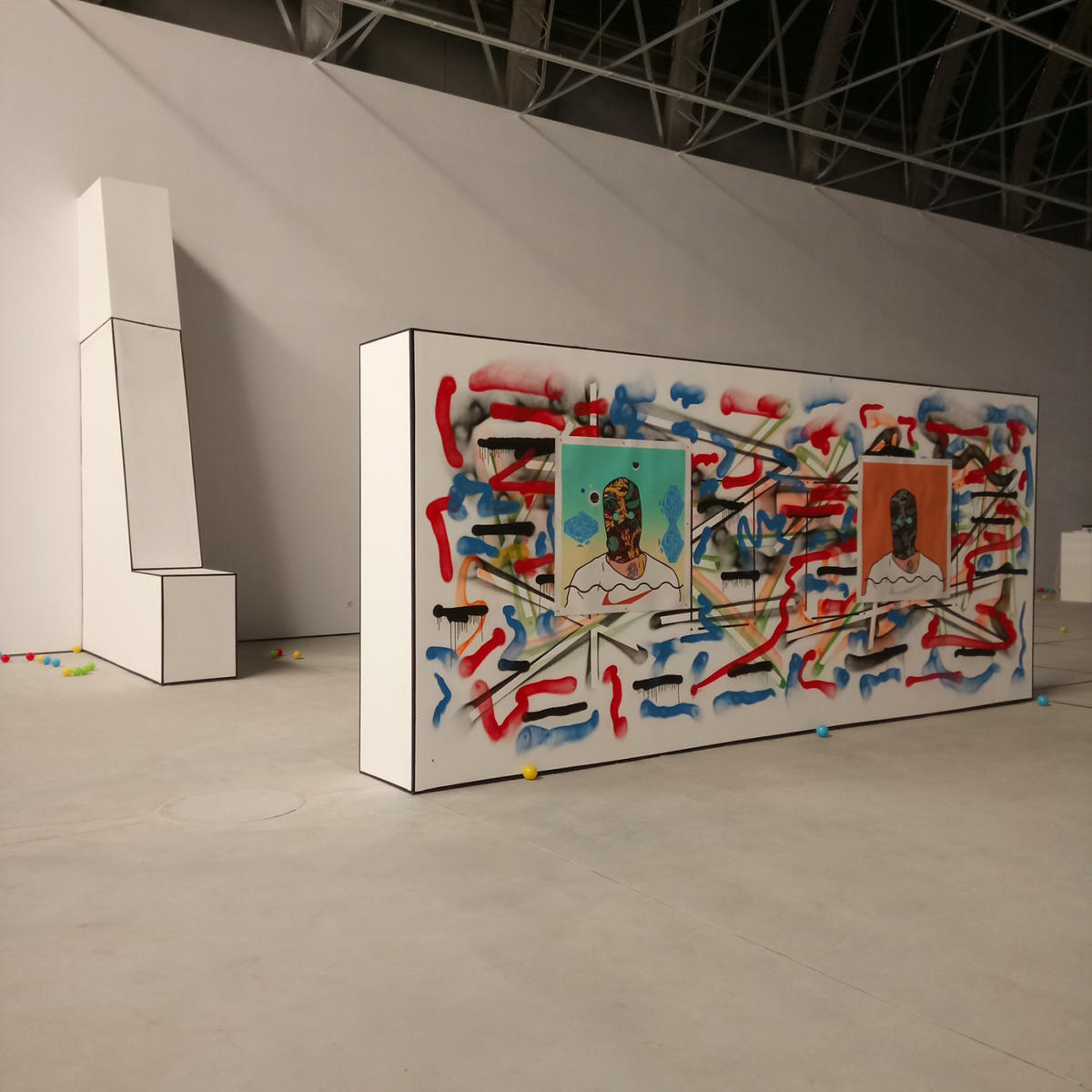

Model „galeria x 2”, doprowadzony do nieco karykaturalnych rozmiarów, realizuje w Rumunii także Galeria Nicodim – która być może nie jest tak fajna jak Plan B, ale na pewno jest od niej bogatsza. W Bukareszcie galeria podnajmuje więc ogromną przestrzeń służącą kiedyś jako pracownia rzeźb monumentalnych, a drugą filię ma w Los Angeles. Współpracuje także z gwiazdami rumuńskiej sceny i chętnie zaprasza do siebie znanych zagranicznych twórców, starając się być rumuńską wersją Gagosiana. „Strategia galerii Nicodim jest tania, ale się sprawdza” – usłyszałam od pewnej znawczyni lokalnej sceny, a po obejrzeniu aktualnej wystawy właściwie musiałam przyznać jej rację. Akurat trwał tam pokaz prac George Cringasu – ponoć dobrze rokującego artysty, który potrafi sprawnie posługiwać się estetyką post-internetową, ale na tych czysto estetycznych zabawach kończy się jego pomysłowość. Jego prace mogłyby być ciekawe w 2009 roku w internecie, ale nie w 2017 w galerii komercyjnej, gdzie są po prostu łatwym produktem na sprzedaż.
Smutno mi się od tego wszystkiego zrobiło (ja w końcu też jestem z pokolenia post-internetowego, miałam kiedyś tyle nadziei w związku z tym trendem, a teraz za każdym razem jak się natykam na jakieś post-internetowe dzieło to wychodzi z tego syf), więc na pocieszenie powędrowałam jeszcze do znajdującej się po sąsiedzku galerii Sandwich, prowadzonej przez dwójkę artystów, Cristiana Radutę i Alexandru Niculescu. Galeria wzięła swoją nazwę od miejsca – prowadzona jest pomiędzy dwoma blaszanymi barakami, przestrzeń wystawiennicza ma 1.5 na 8 metra. Ten kanapkowy metraż stał się tłem dla instalacji Mihaia Iepure-Górskiego Since we are talking about mountains, na którą składała się podwieszona na hakach „góra” z ciemniej tkaniny i towarzyszący jej neonowy napis w trzech językach: „Munți de căcat / Mountains of shit/ Montagnes de merde”. Prosta, a jakże wieloznaczna w swoim przekazie praca Iepure-Górskiego idealnie wpisała się w moje generalne wrażenia z Rumunii – kraju, który w zasadzie przypomina mi Polskę, tylko ciągle jest tu gorzej, nawet pomimo panującej w Polsce politycznej „dobrej zmiany”, którą od półtora roku energicznie wprowadza nowy, konserwatywny rząd. Niemniej jednak wydaje mi się, że góra gówna z galerii Sandwich mogłaby z powodzeniem zostać przeniesiona do Polski i wystawiona w ramach obchodzonego przez nas Roku Awangardy, któremu patronuje prezydent Andrzej Duda. Co wy na taką współpracę, bracia Rumunii?
Artykuł powstał w ramach East Art Mags, programu rezydencyjnego dla krytyków z Europy Środkowo-Wschodniej.
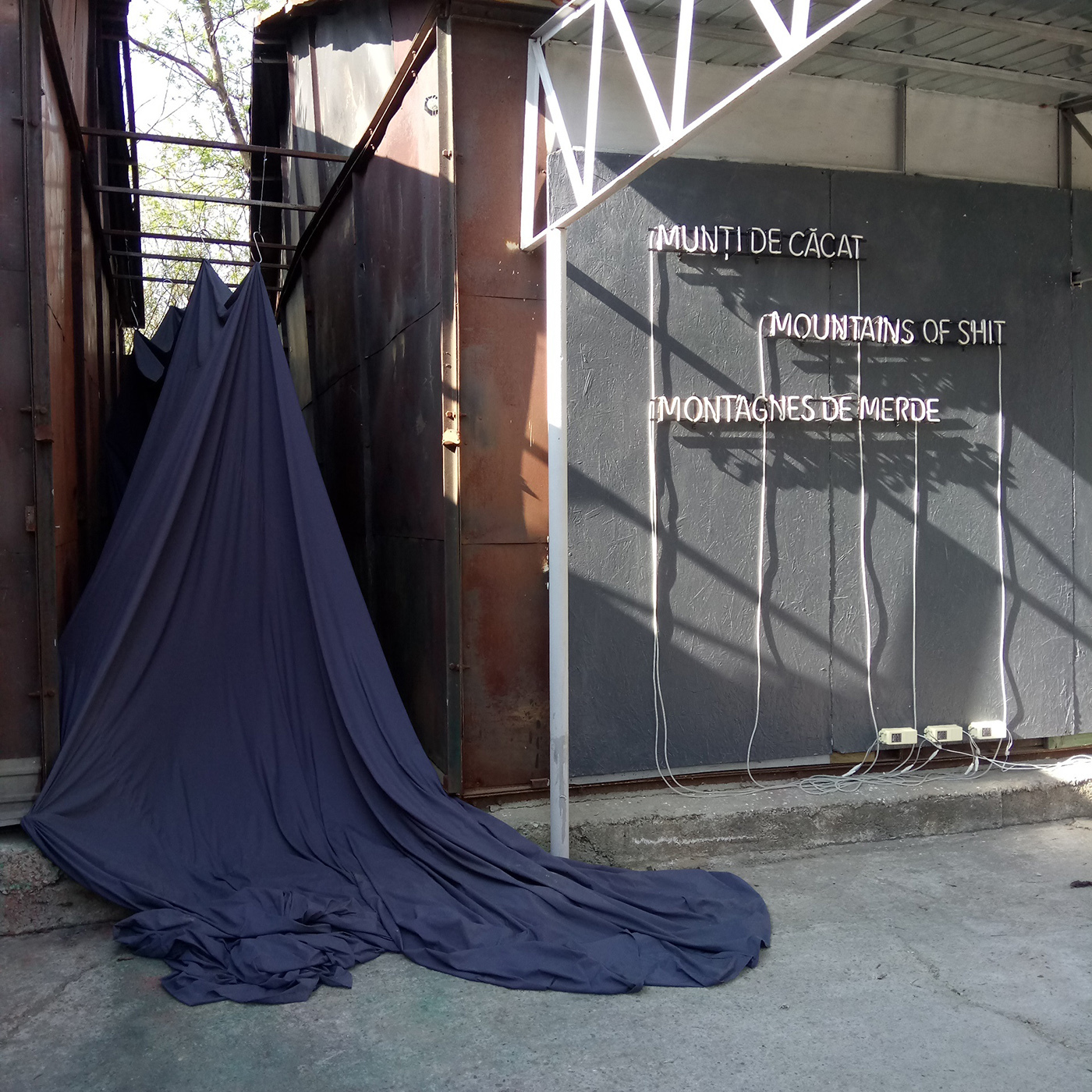
Mihai Iepure-Górski, Since we’re talking about mountains, 10 marca – 30 kwietnia 2017, Sandwich gallery
ENGLISH
Munți de căcat. Tales from the worse part of Europe
The idea of Central European integration is truly beautiful and worth cherishing, also in art. Not so long ago I envied Ziemowit Szczerek his travels to Ukraine heavily fuelled with the famous Vigor balm, and now I am starting to get into his shoes, willingly making friends with my neighbors and exploring seemingly exotic countries. Romania, for example. If you asked me some time ago about Romanian art, my sequence of thoughts would be quite short: Cluj, The Brush Factory, The Plan-B Gallery, paintings of Serban Savu. After all, even in the Warsaw’s Zachęta, in 2014 we could see the exhibition of Victor Man’s paintings, so we learnt that the so-called “Cluj school” is a heavy phenomenon, with predilection to muddy colours, and stunning with melancholy aura, which has contributed to the significant success of painters representing this trend.
The provenance of this specific aesthetics becomes more or less clear at the moment of entering Bucharest which is basically comparable to entering Warsaw, but worse. There are long bundles of liana-like wires running along the road hanging on poor wooden poles – a phenomenon known to Polish readers of Małgorzata Rejmer’s reportages – accompanied by funky and unwanted billboards and great pavilions of Ikea, Leroy Merlin and other chains. This scenery is illuminated by banal orange lamps, giving a futuristic, post-catastrophic effect that can also be seen in the city center, where the streets are adorned not only with electric nests but also with numerous flocks of cars, annexing every free space of pavements and leaving the potential passers-by no other option to walk but the roadway. Traffic congestion and wild roadside micro-architecture are so typical to this city that they even inspired Vlad Nancy, one of the artists I had the pleasure to meet in Romania.
The local artistic millieu bears some similarities to the compressed Bucharest sky and the ground: it is small and seemingly self-important. The natives I met on my way often repeated: “Bucharest is not Warsaw” – and all efforts to explain the crisis situation in Poland and our desperate attempts of getting up off our knees were misunderstood. To my great surprise, I had to take on the role of a visitor from the country of success and to watch the Romanian failure, although – myself an inhabitant of this worse part of Europe – I knew such failure quite well.
Ventilation of communism
It must be admitted that, compared to the quite well-developed Polish art scene, the Romanian one seems modest, for it consists of only three cities: Bucharest, Cluj-Napoca and Timişoara. Some claim that there are still some artists living in Iaşi, a town near the border with Moldova, however it experienced the period of its artistic splendor in the 1990s and today there is no point of going there. As for the institutions presenting art, there are only two of them in Bucharest: the National Museum (the most recent works in its collection represent early Modernism), and The MNAC (National Museum of Contemporary Art). As befits a national institution, it also includes a collection of national artistic goods, comparable to the collections of the Zachęta National Gallery of Art – namely, a typical post-communist hodgepodge, in which good works are dominated by mediocrity. At present, these collections can be seen at the Marshalling Yard exhibition, refreshed once a year, and on the ground floor of the Museum. At first glance it is attractive: it is interesting to finally see such a collection, a testimony of the communist artistic system. To Polish audience it may resemble the excellent exhibition Skontrum organized in Królikarnia palace, presenting sculptures from the Warsaw’s National Museum transformed into one expressive installation and supplemented by works of younger artists (Nicolas Grospierre, Agnieszka Polska and Jan Szewczyk). However, contrary to the Warsaw presentation, the MNAC one has purely practical justification: the Museum is renovating its store rooms and a part of the collection is simply stowed in exhibition halls. Thus there is no need to seek a deeper meaning in this exhibition, which is, in principle, an anti-exposition too (some works are locked in boxes or arranged in a way that makes is impossible to see them), and as such can be understood as a performance of a museum unconsciousness.
MNAC manages to be a perfectly featureless institution. Piotr Piotrowski defined the museum’s strategy as „traumatophobic„ – fleeing from the traumatic past and concentrating on the presentation of global art.
But that is the very charm of the MNAC. The institution is basically overwhelmed by a communist heritage yet it has decided to ignore it flatly. The museum is located in the famous Palace of the Parliament, one of the largest buildings in the world, and the architectural child of Nicolae Ceausescu. The building is amazing and hostile to humans: to construct it, the area of seven square kilometers in the center of Bucharest was turned into a desert. Although there are several gates to the Parliament, it takes a terribly long walk to get to the MNAC, because art admirers can use only one entrance. Those who manage to make a long trip along the decaying concrete fence, separating the parliament from the city, will see the overgrown “garden” at the back of the palace and another building under construction: the giant monastery, the Romanian equivalent of the Polish Temple of Divine Providence. “In Romania, the church has always been to the authorities,” I am informed by my friends and it is hard to deny this proximity, or actually door-to-door vicinity. Against this radioactive background, the MNAC manages to be a perfectly featureless institution. Piotr Piotrowski has written about this, defining the museum’s strategy as „traumatophobic„ – fleeing from the traumatic past and concentrating on the presentation of global art. It is true that the new director of the institution, Călin Dan, an artist and a former member of the subREAL group, aims to present underrated classics of the Romanian twentieth century art (such as Mihai Olos, who had two consecutive exhibitions in the museum), however, in many respects he continues the traumaphobic policy of his predecessor, Mihail Oroveanu.
During my visit to the museum, besides the amazing “presentation” of the collection, I also could see the exhibition of Oliver Ressler, as well as a performance by Cian McConn and Vivienne Griffin, which was a project organized by a curatorial open call. This event seems to perfectly fit into the framework of traumatophobia defined by Piotrowski. The performance by McConn and Griffin was very interesting in general. Situated somewhere between an exhibition, a concert, and a choreographic show, it focused on life “after the internet,” and gave a nice sense of contact with professional Western art. However, it had nothing to do with the local context. It is also quite difficult to match this event to the institution’s program, consisting in 40% of projects selected in result of competitions. This strange situation was only slightly improved by the just-about-to-close exhibition of Botea Bucan. She focuses on various memory policies and the subject of the Palace of the Parliament was one of the issues raised by her. One may only ask how to relate this single gesture of the artist to the museum’s strategy of avoiding difficult topics?
Operation on open wounds
The MNAC, the institution ruled by the artist-director representing the generation marked by post-communist traumas, is unlikely to shoulder a social discussion about the past of the country in the near term. Interesting, however, was the effort undertaken by the Bucharest National Museum, where the exhibition titled Art for the People? was opened at the end of 2016. It was the first show of Romanian communist art – with intention not just to ventilate store rooms, but to make pioneer efforts of shedding light on the period of art superseded from collective memory. Its curator, Monica Enache, a researcher working in the museum’s Modernist Arts Department, belongs to the generation associating communism with vague childish memories, thus she is able to look at this period from the distance, assuming that its critical analysis is necessary for understanding of one’s own history and culture. In turn, the curator’s statements make it possible to realize the size of oblivion. In the interview for ARTA magazine Enache admitted that she worked on materials untouched for years and that she was the first who processed them, so she actually played the role of the creator of the discourse. From Polish perspective, this is a surprising statement, bearing in mind that in our country the research on socialist realism has been taking place since the 1980s, and that the first exhibition of socialist realism took place in 1987 (Oblicza socrealizmu [Faces of socialist realism], in the National Museum in Warsaw), and that the Gallery of Socialist Realism the Palace in Kozłówka was opened in 1994. The art of socialist realism is also constantly analyzed in Poland, in reference, for example, to Andrzej Wróblewski and his mismatch with this trend, or through links with Western Communism, as in the case of the exhibition Daleko od Moskwy. Gérard Singer i sztuka zaangażowana [Far from Moscow. Gérard Singer and the Engaged Art] in the National Museum in Szczecin (2016, curator: Szymon Piotr Kubiak).
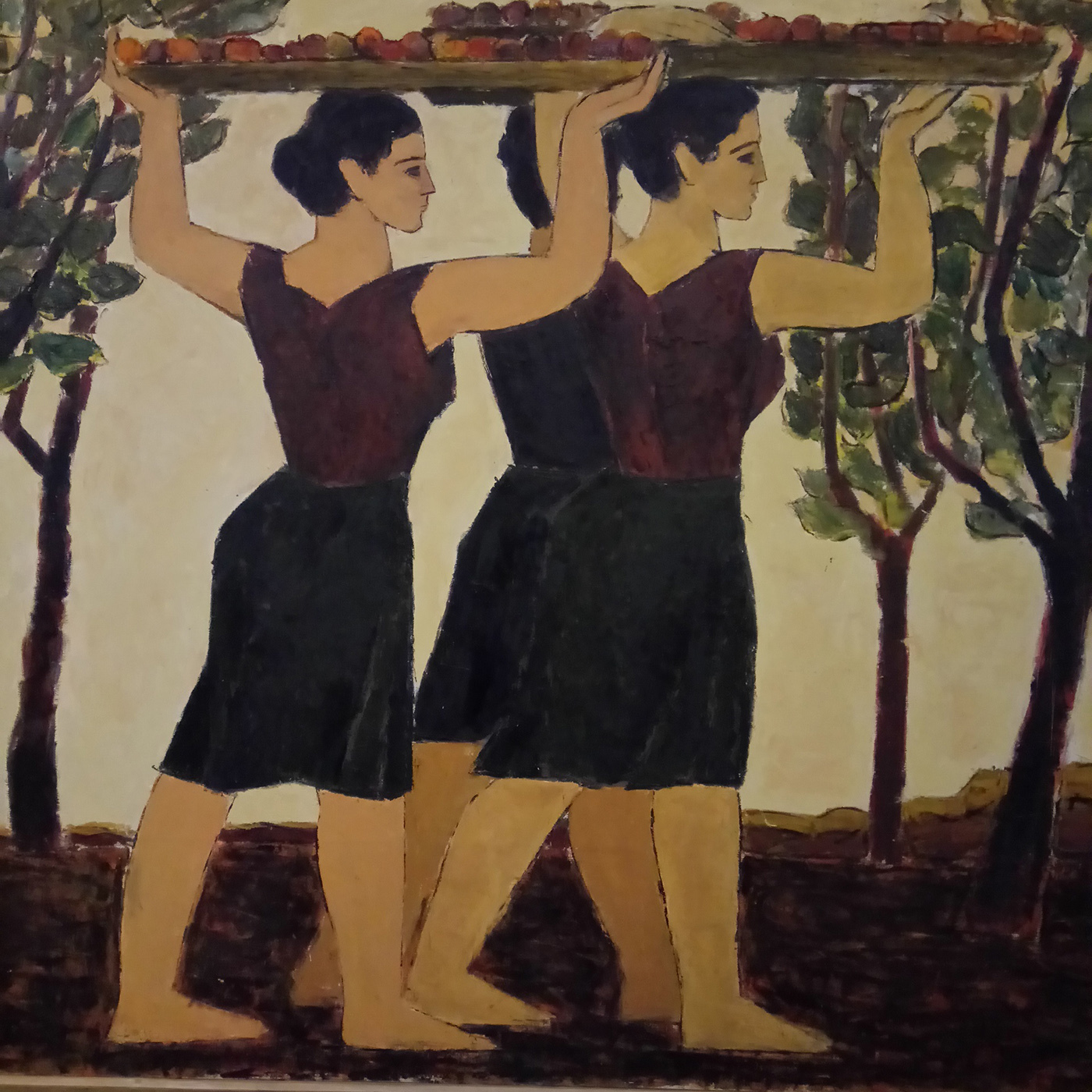
Ion Alin Gheorgium, Fruit Harvesting, 1962, picture from the exhibition: Art for the people?, MNAR
The reasons for such a late take on the theme of socialist realism are probably to be found in the political situation in Romania, where the regime was simply stronger than in Poland, thus the problem of pro-governmental artistic production is actually still an “open wound,” as Enache puts it. In this respect, she must be appreciated for her determination and courage to dig up forgotten works. One can only wish the topic was presented in more interesting or more provocative manner; Art for the people? is a relatively simple exhibition, based on the chronological ordering of works and dividing the artifacts basically into two periods: the reign of Gheorghe Gheorghiu-Dej (1948–1965) and the reign of Nicolae Ceausescu (1965–1989). The curator of the exhibition also tries to dispose of the popular belief that after 1956 artists managed to regain some degree of artistic freedom. She shows that even if the stylistic formulas of socialist realism were loosened in the 1960s, it still was still obligatory as far as the subject matter is concerned. Such paintings as Fruit Collection by Ion Alin Gheorghiu, or A Tractor Driver by Eva Cerbu Siegler (both works made in 1962), clearly influenced by the mid-twentieth century French avant-garde, are exemplary results of such liberalization of doctrines. Taking into account the breakthrough character of this exhibition, one may only regret that, in principle, the curator does not continue her investigation, and does not analyze, for example, the relations of the Romanian art scene with the West (since the influence was so strong). The exhibition could also include at least some of the works shown at the same time in the MNAC, like numerous portraits of Ceaucescu and his wife, painted in the 1980s, as well as other propaganda pieces. Such presentation could make the audience aware that art of this kind was practiced in Romania in principle until 1989. The greatest work of the visionary Ceaucescu, his palace, was not even finished and is now functioning as a declining relic-in-process; a confrontation with this complex of buildings and with the surrounding urban desert can be a really traumatic experience. Thus it seems to me that Monica Enache’s exhibition is significant in this respect that it opens up a discussion which is fairly important for Romanian art, yet it is definitely only the beginning.
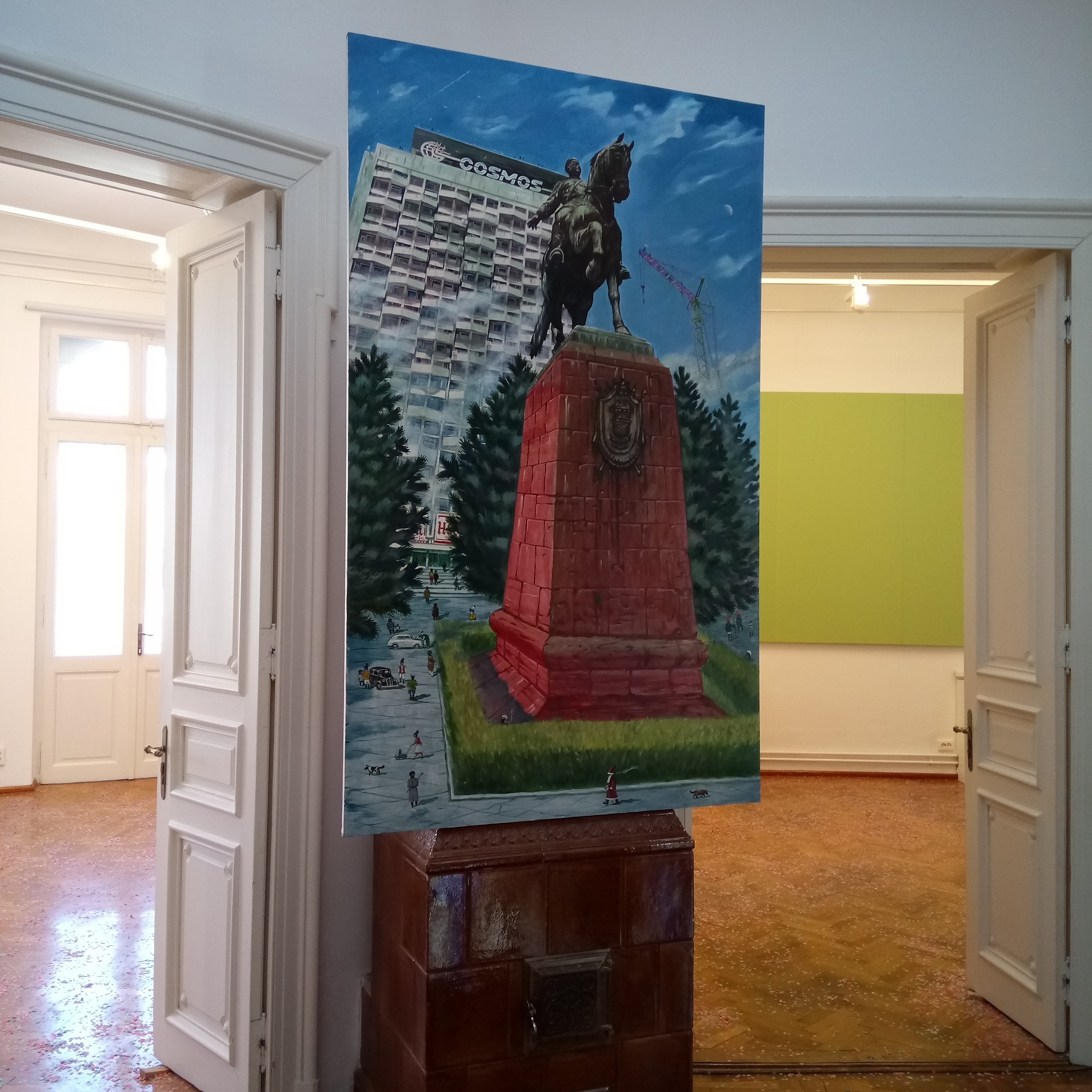
Pavel Brăila, NEW YEAR’S DISSECTIONS, January 13 – April 22 2017, Eastwards Prospectus
An interesting question that may be raised in this context is who could continue such a debate in Romania. Other Bucharest-based galleries or smaller “initiatives” seem to be focused on contemporaneity, or on revalorization of historical phenomena situated beyond the political mainstream. During my visit to Romania, I was able to see a small exhibition of titled Situations and concepts at Salonul de proiecte (accidentally, a gallery now independent, yet in its first years acting as part of the MNAC) – a presentation of archives of the exhibition of conceptual art organized by Decebal Scriba in Bucharest in 1974 under the same title. For a viewer from outside of the Romanian milieu it was perhaps a bit hermetic and not particularly engaging, yet it seems to be a general problem with presentation of the twentieth century conceptual art. It is represented only by photographs, notes and ephemeral documents, usually locked in glass cases, so it is difficult to draw a particular pleasure from visiting such exhibitions. However, what is more important perhaps, is the fact that the exhibition Situations and concepts is actually a part of the larger process of rediscovering Romanian neo-avant-garde. Another event within this series is the opening of the already mentioned exhibition of works by Mihai Olos in the MNAC.
The new Berlin is cool, but the old one is better
Most of the exhibitions I saw in Bucharest were rediscovering more or less forgotten stories from the cultural past (for example, the exhibition of gay magazines and homo-archives of Adrian Newell Păun in the non-commercial ODD gallery in the Bucharest Old Town), or the artists I met had already been renowned in the world of art (like Pavel Brăil, whose exhibition at Eastward Prospectus preceded the artist’s presentation at Documenta 14). Thus, to find some fresh stuff I decided to go to Cluj-Napoca, the northern gallery hub. The trip was somehow heroic: after eight hours on Romanian train I longed for the Polish Intercity and Pendolino. However, it turned out to be beneficial to me for it provided the opportunity to get a taste of local conflict leading in recent months to a spectacular “divorce” between galleries which used to cooperate within the Brush Factory. To be honest, my thorough investigation on who cheated and abused whom, and who robbed the common funds was much more exciting than the exhibitions presented in the Brush Factory. The Factory was actually quite empty, for some of the galleries had just moved to a new building just off the train station. I was able to see there a perfectly boring show of abstract post-painting by two Berlin-based artists, Philipp Rößle and Linus Rauch, as well as an “exhibition” of a very young artist Larissa Danilov from Iaşi who presented a mini slideshow on one of the bookcase shelves in the cafeteria. She explored the topic of ugly sweaters – quite hard to be called a thrilling issue. I also visited the Superliquidato gallery, where the exhibition of works by Bianka Trifan was just to be opened. I felt quite disturbed by her works for they bore a close resemblance to those by a Polish artist Iwona Demko. I might have left the city completely broken if I did not come across the one-night exhibition in the Pages per minute student gallery. Its activities are based on a simple and cool idea of organizing exhibitions of Xerox copies of works, thus easy to duplicate and distribute. The vernissages are always held elsewhere, and the only permanent element in the gallery is the neon with its name, and, as I suspect, a crowd of twentysomethings, filling a selected “spot”. The works presented at the exhibition represented very different levels, yet for me the event – thanks to its energy and unpretentiousness – was a substitute for the lush, gallery life in Cluj, which is supposed to be here.
The natives call Cluj-Napoca “the new Berlin” and the city undoubtedly competes with Bucharest, even despite the absence of any sensible artistic institution (the local art museum is a fossilized institution which has not yet shed communist standards). The competition with the capital of Germany is a bit less successful: moving of The Plan-B, the most important Romanian commercial gallery, to Berlin actually proves that Cluj clearly loses the chase. Officially, the Romanian branch of the gallery is still operating in Cluj-Napoca, yet more in theory than in practice. For me it seems to be a shady trick of the owners who, on the one hand, want to operate within the real artistic center, yet on the other hand they try to maintain the façade of their uniqueness. The departure of Plan-B from Romania is also an interesting signal concerning the specificity of this scene, apparently not sufficient as far as its market visibility is concerned. In Poland, of course, such a big art market does not exist yet – interestingly – Polish galleries do not decide to move abroad or to open their branches in Western art centers. In recent times the most important of them, the Foksal Gallery Foundation, has invested recently in a spectacular concrete building. Its gravity, which can bring associations with a Renaissance fortress-like palazzo (to make it perfect, the gallery should only dig a moat with water full of sharks and piranhas with a taste for local neo-fascists) eloquently proves the Foundation’s readiness to stay in its own place. This, of course, does not mean that Polish gallery-owners are focused only on local Polish field; quite contrary, they promote their artists through cooperation with foreign artistic institutions and through participation in international art fairs.
The natives call Cluj-Napoca “the new Berlin” and the city undoubtedly competes with Bucharest, even despite the absence of any sensible artistic institution (the local art museum is a fossilized institution which has not yet shed communist standards).
In Romania a model of “gallery x 2”, brought to somewhat caricatured size, is also accomplished by the Nicodim Gallery – which perhaps is not as cool as The Plan-B, yet it is definitely richer. Thus, the gallery rents a huge space once serving as a monumental sculpture studio in Bucharest, and its second branch is located in Los Angeles. It also collaborates with the stars of Romanian scene and willingly invites famous foreign artists, trying to be the Romanian version of Gagosian. “The strategy of Nicodim Gallery is cheap, but it works,” I heard from an expert of a local scene, and after seeing the current exhibition I actually had to admit she was right. It was a presentation of works by George Cringasu, a seemingly promising artist, undoubtedly able to use the post-internet aesthetics quite skillfully. However this purely aesthetic play is the limit of his inventiveness. His work might be interesting in 2009 watched on the internet, but not in 2017 in a commercial gallery, where they are simply an easy product for sale.
All of this saddened me; after all I also belong to the post-internet generation, I used to have so much hope for this trend, and now every time I encounter some post-internet work it turns out to be a crap. To cheer myself up I went to the neighboring Sandwich Gallery, run by two artists, Cristian Raduta and Alexandru Niculescu. The gallery’s name expresses its location: it is situated between two tin barracks, with the exhibition space 1.5 by 8 meters. This sandwich-like space has become the background for the installation by Mihai Iepure-Górski titled Since we were talking about the mountains and consisting of a “mount” made of a dark fabric and hanging on the hooks, and accompanied by a neon sign in three languages: “Munți de căcat / Mountains of shit / Montagnes de merde”. This simple, yet so ambiguous message of Iepure-Górski’s work perfectly mirrors my overall impressions of Romania, the country bearing some resemblance to Poland. In fact, the situation in Romania is even worse, in spite of the “good change” policy energetically implemented by the new conservative government of Poland for one and a half a year. Nevertheless, it seems to me that the pile of shit from the Sandwich Gallery could be successfully taken to Poland and presented within the framework of the Year of Avant-Garde, celebrated by us and patronized by President Andrzej Duda. Romanian brothers, how would you respond to such proposal of cooperation?
 This article was produced under East Art Mags, a residency program for critics from Central and Eastern Europe.
This article was produced under East Art Mags, a residency program for critics from Central and Eastern Europe.
Karolina Plinta – krytyczka sztuki, redaktorka naczelna magazynu „Szum” (razem z Jakubem Banasiakiem). Członkini Międzynarodowego Stowarzyszenia Krytyków Sztuki AICA. Autorka licznych tekstów o sztuce, od 2020 roku prowadzi podcast „Godzina Szumu”. Laureatka Nagrody Krytyki Artystycznej im. Jerzego Stajudy (za magazyn „Szum”, razem z Adamem Mazurem i Jakubem Banasiakiem).
WięcejPrzypisy
Stopka
- Fotografie
- Karolina Plinta
- Indeks
- Adrian Newell Păun Alexandru Niculescu Bianca Trifan Călin Dan Cian McConn Cristian Răduță Eastward Prospectus Eva Cerbu Siegler Galeria Nicodim Galeria Plan B Galeria Sandwich George Cringasu Ion Alin Gheorghiu Irina Botea Bucan Larissa Danilov Mihai Iepure-Górski Mihai Olos Mihai Oroveanu Monica Enache Muzeum Sztuk Pięknych w Bukareszcie Narodowe Muzeum Sztuki Współczesnej - MNAC National Museum of Contemporary Art - MNAC ODD Oliver Ressler Pages per minute Pavel Brăila Plan B Gallery Salonul de proiecte Sandwich gallery Superliquidato The National Museum of Art of Romania - MNaR Vivienne Griffin

